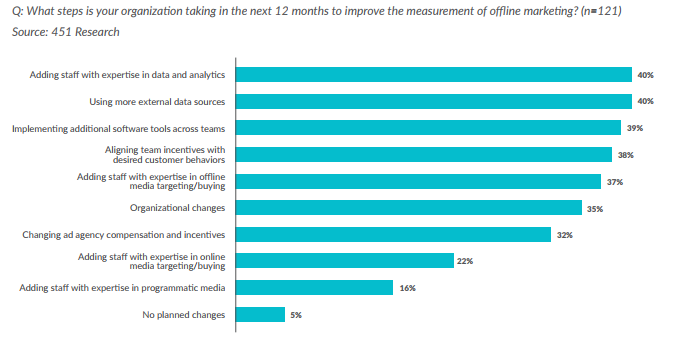How to Link Online Marketing with Offline Sales
Given the abundance of channels available to today’s consumers, it is nothing unexpected to  see them bouncing back and forth between a mix of media prior to making a purchase. Since marketers have no control over which path consumers will choose anymore, having a seamless narrative across all those channels and accurately measuring the performance of each is getting even more difficult. Despite these complicated problems at hand, today’s marketers equally have very advanced technologies that can integrate semantic technology and information science to give deep insight across the entire customer journey rather than spanning just one or two touch points. All they need to thrive is integrating their online and offline channels tightly around a singular, powerful brand message. In fact, integrated marketing has become a high priority for marketers to reach buyers in an increasingly complex consumer journey that stretches across numerous devices and channels, according to a study entitled "State of Integrated Marketing 2017: Mapping the Journey to Success", conducted by research firm 451 Research on behalf of PlaceIQ.
see them bouncing back and forth between a mix of media prior to making a purchase. Since marketers have no control over which path consumers will choose anymore, having a seamless narrative across all those channels and accurately measuring the performance of each is getting even more difficult. Despite these complicated problems at hand, today’s marketers equally have very advanced technologies that can integrate semantic technology and information science to give deep insight across the entire customer journey rather than spanning just one or two touch points. All they need to thrive is integrating their online and offline channels tightly around a singular, powerful brand message. In fact, integrated marketing has become a high priority for marketers to reach buyers in an increasingly complex consumer journey that stretches across numerous devices and channels, according to a study entitled "State of Integrated Marketing 2017: Mapping the Journey to Success", conducted by research firm 451 Research on behalf of PlaceIQ.
Some of the findings from the study bear discussing, therefore, this article will first shed light on the key takeaways from the survey, from there, in light of those highlighted points, we will examine newer measurement points.
One of the things that stands out from the other findings of the research is the shift online and offline marketers are going through. The study suggests that “offline marketers are increasingly turning to search, social and in-app marketing to drive in-store sales.” In the meantime, “online marketers have increased their investments in television, print and outdoor channels with the realization that those channels are not only too big to ignore but offer sophisticated targeting options.”
Furthermore, the study found that for online marketers, the most important measurable goal is customer engagement while for offline marketers, it is brand loyalty. It is important to note that the companies that sell their products and services offline indicated that they see both online and offline engagement as equally important, meaning that even though online is not a channel for them to sell their goods, it is still a powerful instrument for them to drive foot traffic. Therefore, if you think the alignment between online and offline channels is important only for businesses that sell in mixed offline/online environments, you might be leaving money on the table.
Barriers to Linking Online Marketing with Offline Sales and Customer Engagement
If integrated marketing is so important, then, what is standing in the way of organizations to  run a best-in-class integrated marketing program? To find out, the market research firm queried 200 multi-channel marketers operating in North America in categories including automotive, consumer goods, restaurant, retail, and travel. While lack of collaboration across marketing teams was the number one cited challenge, it was followed by a lack of unified measures of success.
run a best-in-class integrated marketing program? To find out, the market research firm queried 200 multi-channel marketers operating in North America in categories including automotive, consumer goods, restaurant, retail, and travel. While lack of collaboration across marketing teams was the number one cited challenge, it was followed by a lack of unified measures of success.
The first roadblock is pretty much self-explanatory, however, the second one bears elaborating on. In the survey, 40 percent of the marketers, who claimed they already run a best-in-class integrated marketing program, also indicated that they have shared performance goals across physical and digital marketing channels, meaning the second most cited reason for failing at executing an integrated marketing campaign is one of the fundamental elements to excelling in it. What would be the main hindrance to effective unified measurement processes then? When we think about the measurement process, data seems to be the currency. With this in mind, the main barrier is either collecting data or the process of translating it into actionable recommendations. Considering the explosion of data and ways of gathering it, I would say it is most likely the latter. PlaceIQ’s research backs me up on that as well, stating: “Our research shows that there is a clear need for marketers to better understand the technology options that are available, align more strategically with IT, or hire in-house experts to support the increasingly technical and complex nature of media and marketing analytics platforms.” The report claims that a large amount of data generated by consumers in the process of decision-making frequently goes unused because of this very same reason.
Without setting up a clear alignment on the goals, execution, deployment, and strategy, a claim on delivering personalized experiences “across all channels” remains vague. Given that personalization is a sophisticated and complex area, there is an exchange of profitable benefit to the organizations for a little bit of time and effort being given away. The time and effort referred to here mostly goes into collaboration around strategy execution and technology implementation.
Being armed with predictive and prescriptive analytics helps marketers uncover hidden opportunities and competitive threats - turning negative customer feedback into promotion, eliminating biased decision-making processes as they take the guesswork out of customer relationships, and gaining a broader view of their positioning against the competitors to name a few. After all, they need to know which steps happen online, which steps happen offline, whether the entire journey is completed through only one digital channel, say, their website, or do visitors wander among different channels. Not only those but also how these visitors react to the brand’s interactions, for how long they spend exploring their content, offerings, and so on.
Using state-of-the-art analytical technologies is a prerequisite for thriving in customer experience. Ben Rhodes, Director of Customer Marketing at Royal Mail, explains this well. “Attribution continues to be a major challenge across marketing channels. Getting the right marketing mix for both digital and offline channels, as well as understanding the impact of earned and paid activity on lead streams remains key in the efficient stimulation of growth.”
The good news is, advanced analytics technology is getting more and more agile. Today, thanks to cognitive computing technologies, some platforms can even provide in-depth understanding of emotions within languages and a customer’s response to them within a marketing scenario, so marketers can capture subtle differences in the language used specifically for reacting to marketing activities.
If you think that these are all great for large enterprises but it is not that feasible for companies with a small marketing budget, then you might be wrong. The same survey unveiled that marketers with smaller advertising budgets (between $10m and $25m annually) are four times as likely to claim to have a ‘best-in-class’ integrated marketing program compared to advertisers that spend more than $50m per year. In the survey, 61 percent of online and 58 percent of offline marketers said they have a “very urgent” need to improve marketing measurement. Roughly one-third of that group plans to institute organizational changes toward that goal over the next 12 months.

Don’t Ignore the Power of Location-Based Data
Speaking of adopting newer technologies and linking online marketing with offline sales,  location-based advertising and marketing technologies have seen a tremendous amount of interest and enhancement in recent years. The idea is measuring ad effectiveness based on foot traffic through a location social app and providing attribution insight based on the action that ads drive at specific locations. In other words, tapping into consumer obsession with mobile devices to trigger local offline conversions through the power of location data. That being said, marketers are still in the experimental stage when it comes to making effective use of location-based marketing. The survey revealed while only about one-quarter of marketers have deployed customer location data in their measurement stack, 81 percent rank that data as the first or second most important element.
location-based advertising and marketing technologies have seen a tremendous amount of interest and enhancement in recent years. The idea is measuring ad effectiveness based on foot traffic through a location social app and providing attribution insight based on the action that ads drive at specific locations. In other words, tapping into consumer obsession with mobile devices to trigger local offline conversions through the power of location data. That being said, marketers are still in the experimental stage when it comes to making effective use of location-based marketing. The survey revealed while only about one-quarter of marketers have deployed customer location data in their measurement stack, 81 percent rank that data as the first or second most important element.
While marketers are tapping into the immense opportunity this type of granular information can provide, they need to keep in mind that it is also important to construct an environment of trust that maintains a level of personalization as with this type of data, their businesses are wading into the intimate world of consumers’ personal lives. Nevertheless, this technology gives a unique opportunity to marketers who want to create interactive experiences throughout offline and online channels as they don’t need to guess where their audiences are hanging out and what messages resonate with them.
My POV
As mentioned earlier, it’s not necessary to be a mega-brand with a huge budget to have great, integrated marketing programs. Authenticity is the first element and it can be provided through evoking emotions like humor, offering a conspicuous value, solving a specific problem or creating an experience they’ll want to share. The second element is conveying a clear and consistent message tied to an audience’s needs across all the channels that they are is on. Lastly, setting up unified metrics to measure goals for online and offline marketing activities.

Venus Tamturk
Venus is the Media Reporter for CMS-Connected, with one of her tasks to write thorough articles by creating the most up-to-date and engaging content using B2B digital marketing. She enjoys increasing brand equity and conversion through the strategic use of social media channels and integrated media marketing plans.